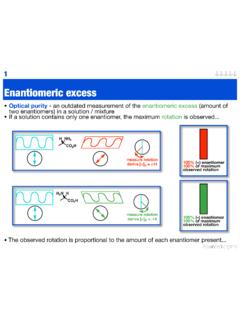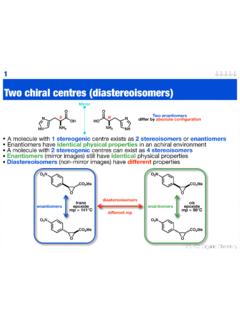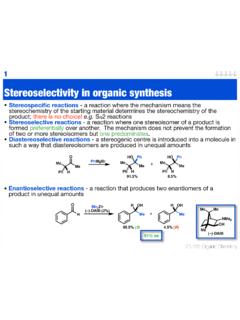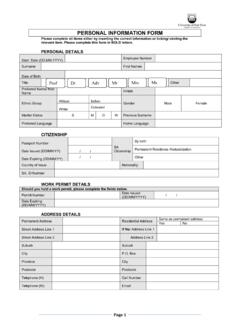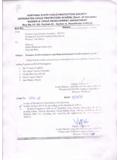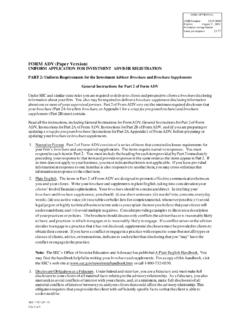Transcription of Carbenes and Carbene Complexes I - Massey …
1 Gareth Rowlands Ar402, , Advanced Synthesis1 Carbenes and Carbene Complexes IIntroduction A very interesting (honest) class of radical-like molecules Steadily becoming more important as they find far more synthetic applications We will primarily concentrate on their synthetic uses and not a theoretical treatment of their structure and reactivity. Having said that we do need to look at some of the CarbenesRCRcarbenesinglet carbenetriplet carbenerepresentation A Carbene is a divalent carbon species linked to two adjacent groups by a covalent bond It possess two non-bonding electrons and six valence electrons If the non-bonding electrons have anti-parallel spins then singlet Carbene If the non-bonding electrons have parallel spins in different orbitals then triplet Carbene Generally Carbenes are expected to be triplet Carbenes (Hund's rule) but substituents can change this and in organic chemistry we normally use singlet Carbenes They are electron deficient like carbocations But they possess a non-bonding pair like carbanion hence can be represented as shown above The nature of substituents R have profound effects on the electronics of the Carbenes and their reactionsCarbene Complexes Carbenes can be stabilised by complexation with transition metals Two extremes are known (as well as the whole spectrum inbetween)R1R2[M] + R1R2[M] + Fischer carbenesSchrock Carbenes Carbene Complexes of low valent / low oxidation state 18 e metals are electrophilic at carbon and are called Fischer Carbenes (often behave like a glorified carbonyl group)
2 Carbene Complexes of high valent / high oxidation state <18 e metals are nucleophilic at carbon and are called Schrock carbenesCarbenoids A slightly confusing class of compounds Includes intermediates that exhibit reactions similar to Carbenes without necessarily having any structures defined previously For the purposes of this course we will limit ourselves to the following: Decomposition of diazo-compounds in the presence of Rh, Cu, Pd (Next lecture)RCRRCRp-orbitalsp2 Gareth Rowlands Ar402, , Advanced Synthesis2 Free Carbenes One very common reaction for free Carbenes : cyclopropanationCl3 CHOHCHCl3, NaOHClClClOOBnBnOBnOOOBnBnOBnOClClMechan ismClClClClOOBnBnOBnOClClOOBnBnOBnOClClO OBnBnOBnO Carbene approaches from least hindered face concerted reaction with ALL bonds made and broken at same time hydrolysis of chloroform Can be used in the ring expansion of aromatic compoundsOMeClOClClMechanismOClClMeClOMe ClClO Although free Carbenes can be used in a number of other transformations they find little use these days have been replaced by the more selective Carbene Complexes and carbenoids Big problem is the harsh conditions required to form themGareth Rowlands Ar402, , Advanced Synthesis3 Fischer Carbene Complexes Emphasize that this is a simplified view as we are interested in their use in organic synthesisR2XR1 LnMR2XR1 LnM + X = heteroatom (O, S, N)Preparation The most common means to synthesise Fischer Carbene Complexes is from metal carbonyl compounds(OC)5 CrCO+RLi(OC)5 CrRO(OC)5 CrRO(OC)5 CrROR2(OC)
3 5 CrROCOCH3R2 OHCH3 COBrhard alkylating agent eg. Me3O+BF4 or R2 OTf addition / elimination mechanism They are also readily prepared from acyl halidesClClOK2[Cr(CO)5](OC)5 CrClO(OC)5 CrOUse in Synthesis As the Complexes are electrophilic on carbon they behave in an analogous manner to carbonylsNucleophilic SubstitutionPhOMeCr(CO)5Li(OC)5 CrPhOMePhPhCr(CO)5 HClHAldol-like ReactionHOMeCr(CO)5 ROMeCr(CO)5 RBase remarkably stable pKa 8 electrophilic at carbon delocalisation stabilises complexGareth Rowlands Ar402, , Advanced Synthesis4 EtOMeCr(CO)5 OMeCr(CO)5 MeMeO(CO)5 CrPhOHBuLiPhCHO(OC)5 CrR2 OMeR1O(OC)5 CrOMeOR1R2 Michael ReactionLiDiels Alder Reaction(OC)5 CrOMe+(OC)5 CrOMe reacts 104 x faster than acrylateDemetallation Of course to be of any use the metal needs to be readily removed Heteroatom substituted Fischer Carbene Complexes are rather stable Still a number of ways of achieving itOxidationOOW(CO)5 HHOOOHH[O][O] = CAN, DMSO, airC Sn Bond Formation The conversion of the Carbene Complexes to an alternative organometallic reagent allows a variety of further elaborations to be achievedOOHHW(CO)5Bu3 SnOTf, Et3 NOOHHSnBu3 OOHHW(CO)5 HOOHHW(CO)5 SnBu3 OOHHSnBu3 MechanismBu3 SnOTfbasereductive elimination can be used in the Stille reaction, transmetallation etcGareth Rowlands Ar402, , Advanced Synthesis5D tz Reaction(OC)5 CrOMeRbigRsmall50 C 1 COOHRbigRsmallOMe(OC)3Cr+ There are very few reliable methods for the construction of substituted benzenes A very valuable example is the D tz benzannulation Proceeds in one step with predictable regiochemistryMechanism The mechanism is still contraversial Two possible mechanisms Give the most commonly quotedOMeCr(CO)5 OMeCr(CO)4 OMeCr(CO)4 RbigsmallRCr(CO)4 OMeRbigRsmallRbigCr(CO)4 RsmallOMeRbigRsmallOMeO(OC)3 CrOMeRsmallRbigO(OC)3 CrOMeRsmallRbigOH(OC)
4 3Cr CORbigRsmallligand dissociationalkyne co-ordination[2+2]-like 3-vinylcarbene complexCO insertioncyclisationaromatisation rate determining step regiochemistry has the largest substituent facing away from Carbene reduced steric hinderance 4-complexGareth Rowlands Ar402, , Advanced Synthesis6Cr(CO)3 Work-upOOMe(OC)5 CrEtEt+45 C, THFOOHEtEtOMeOOHEtEtOMeOOEtEtMeOOMeair or FeCl3decomplexationMeOHCAN (Ce(NH4)2(NO3)6oxidationOOEtEtOUse in SynthesisOMOMMOMOMeOCr(CO)5 OMeNEtOBnOTBSOOTBSNEtOBnOOTBSMeOMOMOMOMO OMeOTBSOHNHOOMeOOHOHOOHOO+50 C, 35 %5 steps33 %fredericamycin AGareth Rowlands Ar402, , Advanced Synthesis7 Schrock Carbene Complexes Unlike the Fischer Complexes , Schrock Complexes do not have a heteroatom to stabilise "carbocationic" character and are nucleophilic at carbonR2R1M M2+2 R2R1 The most common examples are:TiHTiMeMe Tivia eliminationPetasis' ReagentTiH2 CClAlMeMeNR3 TiTebbe's ReagentNMoiPriPrPh(F3C)2 MeCO(F3C)2 MeCOPCy3 RuPCy3 ClClRSchrock's CatalystGrubb's CatalystSynthetic Applications of Schrock Carbene Complexes Schrock Carbene Complexes play a key role as both reagents and catalysts in organic synthesis They have found widespread application as intermediates in the preparation of organometallics We will concentrate on just two applications.)
5 Olefination and alkene metathesisCarbonyl OlefinationR1R2 OreagentR1R2R3 Last year you met the Wittig and related reactions as well as the Peterson olefination Some Schrock Carbene Complexes can also achieve this transformation Titanium Complexes (like Tebbe's or Petasis' reagent) can olefinate a wider range of substrates than the Wittig reaction They are also far less basic so can be used on more sensitive compoundsGareth Rowlands Ar402, , Advanced Synthesis8 MethylenationTiH2 CClAlMeMeNR3Ti +XROTiORXTiOXR remember Schrock Carbene Complexes are nucleophilic at carbon titanium highly oxo-philic like Wittig driving force is forming M=O X = H, R, OR, NR2 So much more versatile than Wittig[2+2] cycloadditionOOORORROROOORORROROPhOTBSOP hOTBST ebbePetasisDisadvantage Probably the biggest disadvantage of such reagents is that it is very hard to transfer anything other than methylene A number of examples of higher order alkylidene reagents have been reported but they are difficult and expensive to prepare There are one or two exceptions and we will use one to introduce the next equiv Tebbe reagent olefin metathesis a higher alkylidene complex olefinationGareth Rowlands Ar402, , Advanced Synthesis9 Alkene Metathesis The process in which two alkenes exchange their alkylidene fragmentsR+Rmetathesis catalystRR+ volatile so drives reaction to completion The process has found extensive use in both academia and industry Again we will concentrate on two variations.
6 Ring-Opening Metathesis Polymerisation (ROMP) Ring-Closing Metathesis (RCM)General MechanismLnMCH2 +RRLnMCH2 LnMRRLnMRLnMRRLnMRRRLnMCH2 RRR[2+2][2+2]cyclo-reversioncyclo-revers ion co-ordination between metal and alkeneScope and Limitations of Catalysts The two most commonly employed catalysts by organic chemists are Schrock catalyst [Mo] and Grubb's catalysts [Ru]NMoiPriPrPh(F3C)2 MeCO(F3C)2 MeCOPCy3 RuPCy3 ClClRSchrock's CatalystGrubb's Catalyst Schrock's catalyst functions efficiently with terminal and internal alkenes Grubb's catalyst is less reactive, it works with terminal alkenes and only slowly, if at all, with internal [Mo] is stable in inert conditions (away from oxygen or protic solvents) [Ru] is stable on the open benchGareth Rowlands Ar402, , Advanced Synthesis10 Ring-Opening Metathesis Polymerisation (ROMP) Industrially important in the production of polymersLnMRMLnRMLnRMLnRRnLnMR By 1990 12,000 tonnes a year of this polymer was made by ROMPRing-Closing Metathesis (RCM) Over the last decade there has been a dramatic increase in the use of RCM for synthesis Reason for this is that the catalysts show good functional group tolerance Operate under mild conditions Readily prepare medium to large ring sizes which is notoriously hard to achieveLnMMLnMLnLnMLnM+ driving force often the generation of a volatile alkeneSynthetic ApplicationsOOMeO2 CCO2 MeOOHHNMoiPriPrPh(F3C)2 MeCO(F3C)
7 2 MeCO20 C, 2 hrs, 91 % good functional group toleranceGareth Rowlands Ar402, , Advanced Synthesis11 ONSOOHOORONSOOHOORO[Ru]85 %epothilone A RCM capable of forming large rings from highly functionalised precursors no need to protect alcohol with [Ru] catalyst internal alkene not harmed Of course, no lecture would be complete without an example of an asymmetric variant A desymmetrisation strategyOcat. 2 % (5 min.)OH99 % have we learnt? The basic characteristics of Carbenes That Carbenes can be divided in to a number of classes Basic reactions of free Carbenes Use of Fischer Carbenes The use of Schrock Carbenes and olefination and metathesis
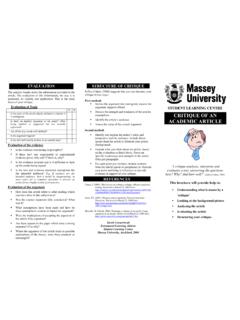
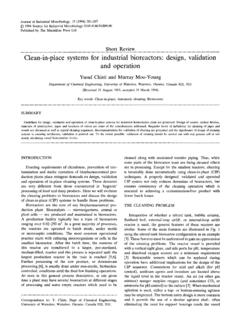
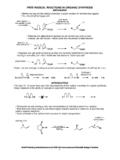

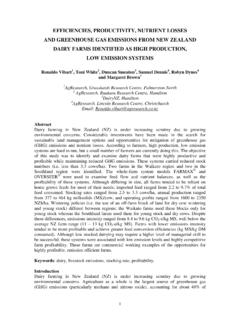
![[3,3]-Sigmatropic rearrangements - Massey University](/cache/preview/0/2/0/3/3/7/7/a/thumb-0203377a43e519e583835c335072f8b8.jpg)
